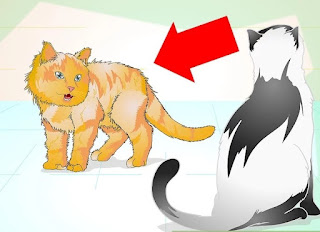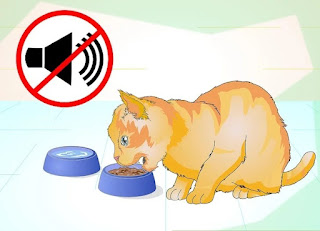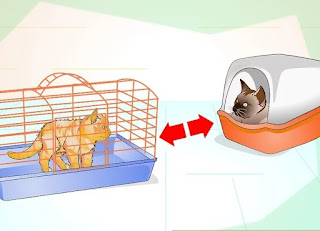How to Properly Deal With an Aggressive Cat
Just like humans, cats have different forms and occasions for aggression. It is usually possible to manage your cat's aggression and even resolve it. Most situations involving cat aggression are entirely manageable and result from fear, anxiety, lack of socialization, or previously traumatic life experiences. The cat deserves our patience and understanding in order to improve its behavior. However, if a cat is habitually aggressive you may need to think about rehoming to a farm where its behavior can be redirected into hunting. For your safety, and the safety of those who come into contact with your cat, it is necessary to understand and manage your pet's behavior.
A Understanding Cat Aggression
1 Look for behavioral patterns. To us, cats can appear baffling or unpredictable, whereas, in reality, we are just poor are reading their body language and understanding what they are trying to tell us. But what we do know is that there are a number of distinct patterns involved with cat aggression. These can be broken into a series of situation-oriented categories that are not mutually exclusive.
- Play aggression happens when cats take play too far.
- Fear/Defense aggression comes from the cat feeling endangered, vulnerable or trapped.
- Territorial aggression is usually just among cats but can be expressed toward humans and other animals.
- Petting aggression is not well understood and may come from over-stimulation.
- Inter-Male aggression relies on the naturally competitive nature between toms.
- Maternal aggression is the queen cat's instinctual protective response.
- Redirected aggression can come from frustration the cat cannot vent, which gets redirected toward another target, such as a nearby cat or person.
- Predatory aggression derives from cats whose predatory instincts are triggered.
- Pain aggression results from old or current sensations of pain.
- Idiopathic aggression is spontaneous and may be a threat to the physical safety of those who come into contact with the cat.
2 Understand your cat's body language. Knowing when your cat is about to go on the offensive or defensive by watching its body language can be key in managing the problem. Watch out for signs of oncoming aggression, as in:
* Defensive postures
- Crouching
- Head tucked in
- Tail curved around the body and tucked in
- Eyes wide open with pupils partially or fully dilated
- Ears flattened sideways or backward on the head
- Piloerection (hackles up/hair stands on end)
- Turning sideways to the opponent, not straight on
- Open-mouthed hissing or spitting
- Quick strikes with front paws, claws out
* Offensive postures
- A stiff, straight-legged upright stance
- Stiffened rear legs, with the rear end raised and the back, sloped downward toward the head
- Stiff tail lowered or held straight down to the ground
- Direct stare
- Upright ears, with the backs, rotated slightly forward
- Piloerection (hackles up), including fur on the tail
- Constricted pupils
- Directly facing opponent, possibly moving toward him
- Might be growling, howling, or yowling
* Overt aggression
- Swatting, striking with paws
- Biting
- Fighting
- Growling, shrieking
- Scratching
- Preparing for an all-out attack by rolling onto side or back and exposing teeth and claws X
3 Note when the aggressive behavior happens. Does the cat become aggressive in the presence of a certain animal or person? In many cases, aggression happens due to a specific trigger. Pay attention to the cat's environment during instances of aggression, so that you can work out what might be causing it, and improve the cat's behavior.
4 Recognize maternal cat aggression. Your cat may become aggressive after giving birth. Mothers have instincts to protect their offspring from potential danger. Maternal aggression can occur when a mother cat (called a “queen”) with her kittens is approached by people or other animals whom she perceives as a threat. It’s more often directed at other cats, but it can be directed toward people, as well. Queens can be quite aggressive when defending their young, especially in the first few days after birth. Avoid handling kittens during the first few days of their lives. Introduce yourself slowly.
- Provide a low-stress environment, keep visitors to a minimum, and avoid approaching or handling either the mother or her kittens if you are met with maternal aggression.
5 Talk to your veterinarian or animal behaviorist. This is very important any time you're dealing with animal aggression, in order to evaluate your options. As there are many different kinds of aggression, some more or less acceptable than others, you will want to make sure your behavior does not worsen the problem.
B Building Trust
1 Give the cat some space. While it's important to make sure the cat is stimulated by its environment, an aggressive cat is unlikely to want to socialize with people. She needs space to learn trust. Rather than dangling a toy in the cat's face, don't try to enforce playtime unless the cat seems to enjoy it.
- When entering the room with an aggressive cat, avoid eye contact and make sure the cat has had a clear escape route. Do not approach an aggressive cat unless necessary; it's better to let the cat come to you.
- If you have to handle the cat, wear thick gloves and long sleeves to avoid getting a scratch injury. To pick the cat up, wrap it snugly in a towel to impede movement.
2 Pay close attention to your cat's body language. Some cats are easily overstimulated, and their play can escalate into aggression. To a cat, play is connected to how it learns to hunt. Play aggression is the most common type of aggressive behavior owners see in their cats.[4]
- It’s believed that through play with each other, young cats learn to inhibit their bites and sheathe their claws when swatting.
- The degree to which individual cats learn to inhibit their rough play varies, and those who were orphaned or weaned early might never have learned to temper their play behavior.
- Long hours spent alone, without opportunities to play, and owners that encourage their cats to chase and play-attack people’s hands and feet contribute to play aggression.[5]
3 Provide a variety of toys for your cat. Some cats prefer toys that they can throw around themselves. Other cats prefer toys that require owner participation, such as those you wiggle and dangle. Stimulating play for a cat involves opportunities to “hunt,” so move toys in such a way that they mimic the movements of a rodent or bird. Introduce new toys periodically to keep your cat from becoming bored with her toys.[6]
4 Spend at least twenty minutes with your cat, twice a day. Forty minutes is not that long for a person. It means a lot for the relationship between you and your cat. This will enhance the bond between you and your pet, and help your cat work out some energy.
- For a truly aggressive cat, you just need to be in the room, lying on the floor, eyes closed, with treats around you. This gives your cat time to build the confidence to know you are not a threat.
- Use a fishing pole toy to keep the cat away from your body when playing.
- Don’t resume playing until your cat is calm if it bites or scratches you.
- Do not encourage your cat to play with your hands, feet, or any other body part. While it may be fun when you have a tiny kitten, it becomes painful and dangerous as your kitten grows up.
- Do not use toys that teach your cat to play with your hands, such as gloves with balls hanging from the fingers. If you do, your cat will be encouraged to direct his play at your hands.
- Do not physically punish your cat for rough play. If you hit your cat, she may perceive your actions as play or become fearful of your hands.
- Don't run from your cat or try to block its movement with your feet. These actions can cause your cat to intensify its play or become aggressive.
5 Build an outdoor enclosure for your cat. A more complex environment for your cat will keep her stimulated, and she will require less attention from you. An outdoor enclosure not only keeps your cat in, but it also keeps other animals away from your cat. Make sure to include platforms and places for her to explore and rest. Cats will spend hours watching leaves blow in the wind, birds flying and squirrels scampering around. If you can’t have an outdoor enclosure, try creating a window perch where your cat can easily sit and look out the window.
6 Try pheromones that mimic a natural cat odor. These are similar to the pheromones cats release when they rub their head on an object. This may reduce tension. Use a diffuser while the aggression is being resolved.[7] Talk to a pest professional about brand recommendations and proper application.
C Using Food to Manage the Behavior
1 Protect cats during feeding times from anything that cause them to exhibit fearful aggression. Examples include loud noises, children, other cats bullying them, and dogs. If your cat fears one or more of these things, it may not eat and may react aggressively. Keeping your cat's environment quiet and still during feeding times will help to calm it.
2 Use food to reward your cat for non-aggressive behavior. Cats will normally associate feeding with positive feelings, and so food can be used as a reward to help condition their behavior.[8] There are a number of techniques you can try:
- To build your cat's trust, find the cat's go-to treat and scatter some around the room during a play session. Try holding treats in your hand and dropping them to get the cat to come closer.
- Expose to aggression-causing stimuli at a safe distance, for short periods of time, then reward with food for non-aggressive behavior. For example, if your cat has an aggressive fear of a specific person, that person might stand at a distance that does not trigger aggressive behavior.
- When working with other cats, they might be kept in large cages at opposite ends of the room, on leashes, or in harnesses, so they can see the source of aggression, but not escape. After several hours, they might be brought closer together. After many such sessions, it should be possible for them to be close to each other, without becoming defensive.
3 Teach your cat to enjoy getting a pet by using treats. Petting aggression isn't a well-understood behavior, even among experienced animal behaviorists. It's thought that some cats just have sensitive spots or limited tolerance for touch. The next time you pet your cat, watch her closely for signs of irritation. As soon as you recognize 'tells' that the cat's tolerance level is about to be exceeded, stop petting, stand up and tip the cat off your lap.[9]
6 Provide several small meals per day rather than one or two large meals to help manage predatory aggression. Avoid “free feeding” (keeping your cat’s bowl full all the time). If your schedule doesn’t permit giving multiple meals, you can purchase a feeder with a built-in timer, designed to open according to a preset schedule. Predatory aggression is shown not to occur when cats eat from a food bowl, but only with objects perceived as prey [11]
D Exposing the Cat to Another Cat
1 Start with a slow introduction. Most territorial aggression is directed toward other cats. Managing this aggression can progress in much the same way as the fear-induced aggression acclimation, with gradual exposure.
- Confine the cats in separate rooms with litter, food, and water. The two cats should be able to smell and hear each other through the closed door, but there should be no physical contact.
- After a few days, switch the positions of the cats. Allow your cat to investigate the smells of the newcomer, while the new cat explores the house and the scent of his new playmate.
- Switch them back after they have had some time to explore
2 Introduce cats to each other during feeding times. Both cats should be fed at the same time so that they learn to associate the pleasure of eating with each other's presence.[12] Position one cat on each side of a room, several times a day, and try to feed them small amounts of food. Hungry and occupied with eating, they will begin to associate the other cat with this non-threatening situation.
- If the cats eat without becoming aggressive, you can then try to bring the food bowls a little closer together each day.
- If the cats won't eat or become aggressive, they are probably too close together. Try again later, this time positioning them farther apart.
3 Restrain two combative cats on opposite ends of the same room, either in carriers or restrained with harnesses and leashes. This can be done in combination with other kinds of exposure.
- This whole process can take weeks or even months. Signs of anxiety or aggression usually indicate that the introductions are proceeding too quickly. If the territorial aggression still cannot be controlled, your veterinarian may prescribe medication for both the aggressor and the victim. Keep in mind that medication is only part of the solution; it must be used in conjunction with slow introductions and consistent rewards for peaceful behavior.
E Intervening in Extreme Cat Aggression
1 Block your cat's exposure to the outside world. You can install electronic mats that deliver a harmless, mild shock, or put sticky tape on your windowsills. Window blinds are also effective deterrents. You can discourage outdoor animals from coming near your house by installing motion-activated sprinklers, removing bird feeders, and using well-sealed garbage containers.
2 Muzzle or gently restrain an aggressive mother. This is for situations when the kittens must be handled, and the mother is not permitting it. More is less in this case. Take care not to overly stress any of the cats. A blanket can work in certain situations. Remember that her aggression comes from a deep, instinctual care for her offspring.
3 Interrupt aggression with a loud clap of your hands, spray from a water gun, or a burst of compressed air.[13] If you let the cats fight it out, one or both may become seriously injured, possibly creating more opportunities for aggression in the future. If this kind of aggression is not dealt with, it can progress to fearful aggression [14]
4 Don't physically punish your cat for lashing out. Even yelling at it can make the problem worse. Teach your cat to be calm by remaining calm yourself. Aggression on your part can result in additional aggression from your cat.
5 Be mindful that your cat is much smaller than you are. And though she is capable of injuring you, you are also capable of injuring her. At times when your cat becomes aggressive, don't forcefully throw your cat off of you. She might become afraid of you, or get injured by the fall
6 Give your cat a time-out. When she plays too rough, end the game by leaving the room. Don’t attempt to pick up your cat and put him in another room for the time-out as this could provoke aggression. Take your time as you do this. You do not want to provoke a chase.
7 Do not console the cat. This can communicate your approval of the aggressive behavior. Visitors should not run or show fear, as this teaches the cat that she can make unwanted visitors go away. Ignoring the cat, in this case, can prove to be a more effective strategy
F Seeking Medical Help
1 Neuter the cats. Intact males are particularly prone to aggressive behavior among each other. Getting them fixed is the best way to solve this kind of aggression.[16] Although these males may still spray and be prone to other kinds of aggression, this typically resolves inter-male aggression.
2 Resolve or alleviate their pain. This is the best way to manage aggression when it stems from illness or trauma. Pain-induced aggression is triggered by pain, frustration, or deprivation, and can be directed toward people, animals, and objects. Any animal—including humans—can aggress when in pain. So even a well-socialized, normally docile cat can lash out when it is hurt when someone tries to touch an injured area, or when it is in pain and anticipates being handled
3 Have cats with aggression problems examined for underlying medical problems. Painful diseases such as arthritis, dental pain and abscesses from fighting are common sources of pain-related aggression. By diagnosing the problem quickly, you can avoid the cat developing trauma-based aggression. Allowing an issue to remain undiagnosed can cause the problem to worsen.
- Body postures will usually be defensive. A cat that dislikes being touched in a painful area may display pain-induced aggression in an attempt to stop you from handling it.
- This behavior can also be associated with past trauma. For example, a cat whose tail was once caught in a door may be protective of its tail long after the pain is gone [18]
4 Handle sick cats as gently as possible. Wear gloves if necessary, and give them food treats so that they associate your touch with a tasty reward. If they act aggressively while you are handling them, do not reward them with kind words and petting; this demonstrates that aggressive behavior is acceptable. Remain calm, and this will help keep them calm.
5 Ask your veterinarian about medications that can help your cat cope with its pain. These can reduce pain-related aggression. There are a variety of medications that are effective at managing pain in cats. It is possible that with the right prescription, you will be able to reduce your cat's discomfort and aggression.
6 Consult your veterinarian or an animal behaviorist to evaluate your best options in the case of idiopathic aggression. Redirected aggression must be closely considered and ruled out as a possible cause before a diagnosis of idiopathic aggression is made. These cats are dangerous, and owners of such cats should carefully assess their quality of life, as well as the safety of those around them.[19]
- Find ways to relieve the cat's stress.
- Reevaluate the cat's presence in your home. However, you should be extremely cautious about placing her in a new home; you don't want to pass your problem on to someone else.
7 Rule out other factors before considering euthanizing your cat. In most cases, it is not necessary to put an animal down due to aggression. Consider all other options before taking this route.
- Aggression from an illness might be a sign of great pain. In cases where the problem cannot be adequately treated with medical care, euthanasia can be the kindest option. Talk with your veterinarian about whether or not this is the best choice when treatment is too expensive or unlikely to provide relief.
- Idiopathic aggression includes any type of aggression whose cause can’t be determined or explained through behavior history or medical exam. Cats with this type of aggression can attack their owners violently. They may bite repeatedly and remain in an aroused state for long periods of time. Talk to your vet about how to handle this type of aggression.













































0 comments